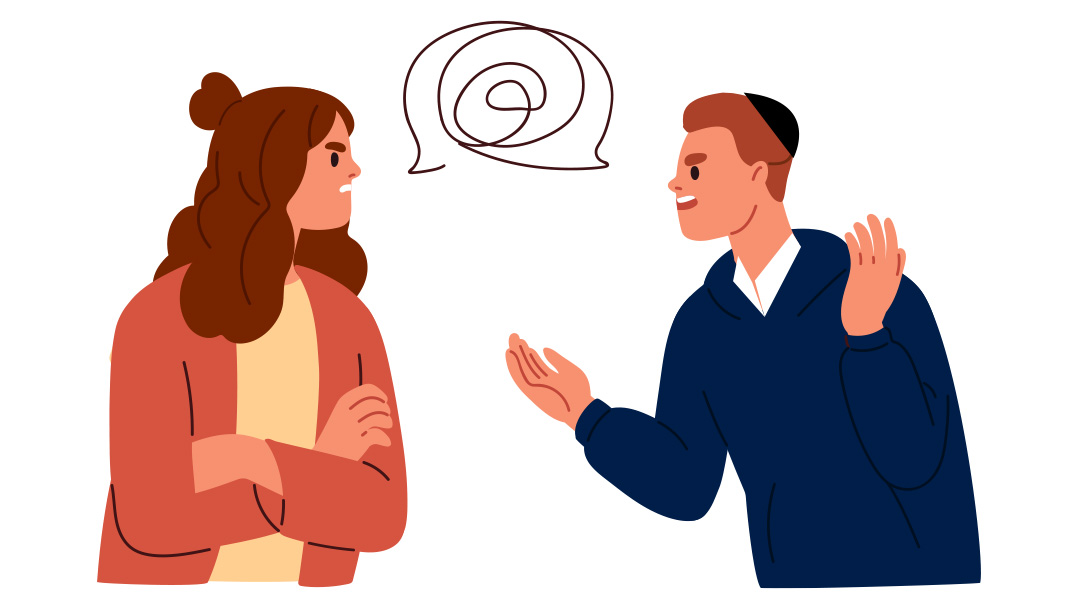Autofights
| October 17, 2023Couples often feel they have arguments on repeat — and the more they fight about the same thing, the less they feel heard

Autofights
Abby Delouya RMFT-CCC, CPTT
Shevy slumped down on the couch and looked at her husband before turning to their therapist. “We have the same fights over and over again! It’s both maddening and exhausting!”
Shevy’s complaint isn’t unique; couples often feel they have arguments on repeat — and the more they fight about the same thing, the less they feel heard. Couples wonder why this happens and whether it’s even possible to stop this cycle.
There are two things needed to have a persistent fight: 1) a sensitive, likely historical pain, and 2) a strong, defensive protection around feeling that pain.
Fights occur when we become more focused on survival rather than connection. When we feel pain but cover it with emotional armor and defenses, it’s easier to get lost in the content of the argument rather than the underlying feelings and motivations.
There are three central experiences that usually get activated when couples fight. They are:
- Feeling disrespected
- Feeling unsafe due to lack of trust
- Having different needs for connection and independence
When we realize that there is a pattern or potential predictability to our activation, we can take a pause and check in with ourselves to work for a reframe. These “mind checks” work well to help break the cycle of a fight on repeat:
- What am I feeling? Instead of focusing on the specific incident, try to tap into what feeling is being triggered. Split up your reactions into two parts: 1) when you do “x” (leave your clothes on the floor, don’t ask about my day, etc.), I feel “y” (like you don’t value my time or I feel lonely). By changing the conversation course to your feelings, you stay away from defensiveness and blame. Hopefully, your spouse will be better able to meet you in vulnerability rather than through attack.
- Where is it coming from? If it’s hysterical, then it’s likely historical. If you can identify that you are feeling loneliness, for example, you can dig deeper to try pinpoint when you first experienced that emotion — and share that with your spouse. This is a process that allows your spouse to see why your trigger is a sensitive one without getting into the blame game, because your earliest memory of this feeling didn’t start with him/her. It also shares a part of yourself in a way that hopefully elicits understanding and care.
- What do I need? It’s easy to hop on the defensive train and ride it all the way home. It picks up steam as we add accusations and we end up feeling spent and disconnected. Sometimes saying what your spouse did wrong or didn’t do at all is easier than identifying what you need, but it’s far less effective.
Instead of: “You always come home so much later than everyone else,” try: “I need your help with the kids/your attention and it feels like you have a lot of other priorities.”
If you feel too flooded to figure out what you need, see if it’s possible to take a time-out from the argument and ask yourself directly — “What do I need in this moment?”
- Can we normalize some arguments/patterns of disagreements? Create a narrative together that speaks to your patterns of disagreements so when it happens, you can refer back to it, and perhaps even make light of it.
“Erev Yom Tov is always very stressful for us and we can get stuck on different things. We can get into discussions about who is doing what and get into a competition about who is more overwhelmed.” When it comes up again, saying something like, “Oh, here goes the story again… let’s not get into this fight right now,” can at least delay, and possibly interrupt habitual arguments.
At a less stressful time, you can sit down and try to discuss the core need or feeling that is coming up, while remembering that connection and support is always the best option. For example, “I tell you that I’m doing so much because I really want to feel appreciated and acknowledged for my hard work. How can I say it differently so that you hear me, but it also feels like we’re on the same team?”
- What would we be doing together if we weren’t fighting? Paradoxically, sometimes we fight in order to connect. Engaging in fighting can flood us with all sorts of chemicals, and even though it’s a negative experience, we may still welcome the intensity. Asking this question taps into a healthier part of ourselves that is seeking closeness.
What would you be doing if you weren’t fighting? Maybe you would be relaxing on the couch, maybe you would be spending time together as a family, maybe you would be getting some chores done together…. Open yourself up to the possibility of shifting away from the same old fight, and toward new avenues of connection and closeness.
Abby Delouya, RMFT-CCC, CPTT is a licensed marriage and individual therapist with a specialty in trauma and addiction.
Anger: An Analysis
Sarah Rivkah Kohn
Anger is known as a secondary emotion. What that basically means is that most often there is an emotion we prefer not to connect with and so we cover it with anger instead.
The first thing to know about anger is that it is often a form of self-protection. We may be hurt or jealous or experience a range of other feelings that make us feel vulnerable and exposed. Anger feels like a powerful way of avoiding vulnerability. It says, “I’m not going to take this. I’m stronger….” And presto, vulnerable moment over.
That’s why it never helps to address anger head-on — not one’s own and not others’. It’s much more productive to find the underlying pain point and deal with it, and that’s how the anger dissipates.
Sarah Rivkah Kohn is the founder and director of Zisel's Links and Shlomie’s Club, an organization servicing children and teens who lost a parent.
Goodbye, Diapers
Dr. Jennie Berkovich
Potty training is a significant milestone in a child’s development, signaling their transition from diapers to using the toilet like a “big kid.” While there’s no one-size-fits-all approach to this journey, understanding the basics can help parents navigate this phase successfully.
Every child is unique, and their readiness for potty training varies. Typically, most children start showing signs of readiness between 18 and 24 months of age, although some may be ready earlier or later. We often see boys becoming interested a little bit later than girls. It’s crucial to remember that there’s no fixed timetable, and it’s essential to respect your child’s individual pace. Forcing potty training before a child is ready is often counterproductive and unlikely to be successful.
Some families do well with positive reinforcements like stickers, while others prefer a more aggressive “three-day” method and timed bathroom breaks. Be flexible and adapt as needed. What works for one child may not work for another, and that’s perfectly okay.
Daytime dryness often precedes nighttime dryness. While some children may stay dry at night shortly after mastering daytime training, others may take several more months or even years to consistently stay dry during the night. In fact, 20 percent of children have some problems with bedwetting at age five and up to ten percent still do at age seven. By the late teens, the estimated rate of bedwetting can still be up to three percent.
While every child’s path to potty training is unique for every child, some signs might indicate a need for further evaluation:
- If your child hasn’t shown any interest in potty training or hasn’t made progress by the age of three, it’s a good idea to consult your pediatrician.
- Sudden regression in potty training skills, such as frequent accidents after successful training, can be a sign of stress or underlying issues.
- If your child consistently resists using the toilet and displays severe anxiety or fear, professional guidance may be necessary.
- It’s worth mentioning to your pediatrician if there is nighttime bedwetting after the age of six. Although likely still normal, other causes (like constipation) should be ruled out.
Remember, potty training is a journey filled with ups and downs. Celebrate small victories, be patient during setbacks, and always offer your child support and encouragement.
Dr. Jennie Berkovich is a board-certified pediatrician in Chicago and serves as the Director of Education for the Jewish Orthodox Medical Association (JOWMA)
(Originally featured in Family First, Issue 864)
Oops! We could not locate your form.







